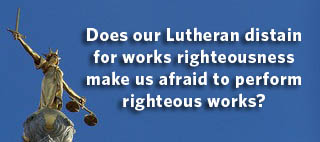 Good Enough Can Be Great
Good Enough Can Be Great
Let’s look at the second principle of Putting Disruptive Innovation to Work.
Noting that “good enough” can be great.
Many innovators seek to leapfrog over existing solutions, essentially hoping to win by playing the innovation game better. Disruptors win by playing the innovation game differently. [emphasis in original] Disruptions are all about trade-offs. Disruptions typically do offer lower performance along dimensions that historically mattered to mainstream customers. They aren’t bad along these dimensions; they are good enough. But they more than make up for that — in the eyes of their customers — by offering better performance along different dimensions.
This is very applicable to church life. Congregations are bombarded with demands to transform. We are competing to reach a standard that no one has measured. The drama sets congregation against congregation as they vie for attention from their regional body in access to professional services and standing. Transform becomes conform.
Concentrating on growing can be frustrating. It can discourage people who never joined church to work to reach other people’s goals. New members need time to settle and mature.
Sometimes churches are exactly the right size. They can afford their pastor. They can maintain their building. People know each other and are sensitive to one another and their community. They work well together and are confident enough in their sense of mission to welcome new people.
So why can’t we accept congregations the way they are? Is the push to grow important to the mission of the church or is it important to maintaining the three budgets each congregation is expected to support (their own, and those of the regional body and national entity)?
Churches will grow if they are growing for the right reasons. Their way of achieving their mission may not suit church professionals, but it may be good enough—at the moment. It may be great.
Redeemer was good enough. Redeemer was great at what it was doing in mission work — which no one else was doing quite the same way. We were not replicating a model foisted on us from above but we were innovating in ways from which others could learn and which we could afford and had the talent to support.
We don’t know what would have made the Southeastern Pennsylvania Synod of the Evangelical Lutheran Church in America happy.
- We had grown five-fold since Bishop Almquist’s interference in our ministry in the late 1990s. SEPA didn’t know that because SEPA ignored us for a decade. When faced with the facts, they simply refused to count the new members. “White Redeemer must be allowed to die. Black Redeemer — we can put them anywhere.” (Bishop Burkat)
- We had achieved diversity, a stated goal of SEPA.
- Our members spanned the age ranges and was no longer top heavy with older Christians.
- We had several pastors interested in working with us.
- We had some money in reserve.
- We had lay leaders with diverse talents that complemented those of professional leaders.
- We had a ministry plan that had the potential to create ongoing revenue.
We were and are good enough. We might even be great.
But recognizing Redeemer’s unique ministry didn’t meet SEPA’s agenda. They needed us to fail so they could justify taking our property (which their Articles of Incorporation forbid, but who cares).
So they quickly, in a blink of an eye, acknowledged our success but followed it with criticism for not achieving it under their direction. (They were AWOL.)
Since they kicked us out of the ELCA, we’ve visited 52 congregations. We know our ministry is just as active and effective as those who sat in judgement over us. And it is unique. We don’t have a food pantry. We don’t sign up for every charity run. Our kids don’t go to Synod youth events. But we do support ministries in other countries. All our kids and families had an opportunity to attend church camp. We have developed a social media ministry which reaches 1500 people a month. We’ve made a project of connecting with other Lutheran congregations. We have fought to maintain congregational polity, which will someday benefit every other SEPA congregation. We continue to meet for worship and ministry weekly.
If we had tried to be like bigger churches we would not have been able to accomplish the things we did. We did our own thing with our own resources and remained true to our mission. If we had concentrated on emulating bigger congregations we would have failed. All of our resources would have been spent keeping up with the St. Joneses. We found areas of ministry in which we could excel and make a difference.
We were good enough, we like to think, to be welcome in God’s house.
We were not good enough, we know, to be welcome in the ELCA.





